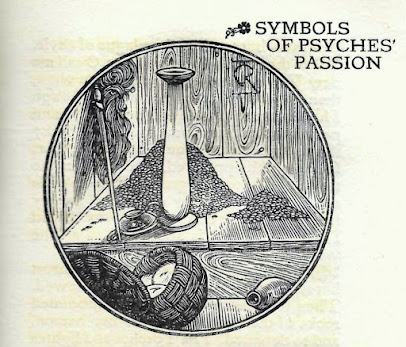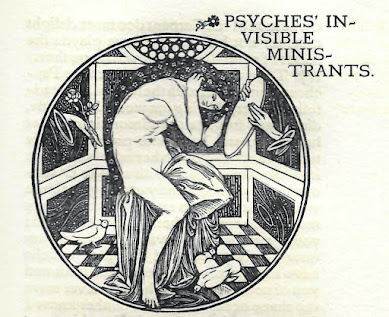On 6 November 1933, the collection of 'the late W.A. Pye. Esq.' came under the hammer at Sotheby & Co in London: 131 lots, including over a page of Vale Press books.
 |
Catalogue of Printed Books
(Sotheby & Co., 6-8 November 1933) |
How William A. Pye got into collecting Vale Press editions is not known, nor when he met Ricketts, but in December 1903 he was among the group of sixty guests who came to admire Ricketts's and Shannon's newly decorated rooms and studios - about a year and a half after the artists had moved into Lansdowne House.William A. Pye
William Arthur Pye was born in Exeter in 1852, the son of assistant organist and composer Kellow J. Pye, who gave up his music career to become a partner of a wine merchant firm, Reid, Pye, Campbell and Hall, in London.
The young William Pye studied at Magdalen College School in Oxford before he too left for the City and went to work as a wine merchant.
He married Margaret Thompson Kidston and they had seven children including the bookbinder Sybil Pye and the artist Ethel Pye. They lived at Priest Hill, a house in Limpsfield, Surrey.
Pye was a great lover of flowers and the Priest Hall gardens were constructed after his design, while he was a successful exhibitor at local shows. He became a Fellow of the Horticultural Society, and a promotor of the Exted and Limpsfield Gardeners Association. He regularly sent special flowers to Ricketts.
Pye died on 2 June 1933.
Pye's artistic circles
Pye developed a passion for collecting oriental and contemporary art. Perhaps that is why he met young Laurence Binyon in the Print Room of the British Museum. Binyon - whose mother had died in 1892 and whose father lived in the north of the United Kingdom - was taken into William Pye's domestic circle after they met in 1895. He became a regular weekend guest in Limpsfield (and earlier in Lee, where the Pye family initially lived).
Nearby lived some families who gave access to modern literary circles: Sydney and Margaret Olivier and Edward and Constance Garnett whose children joined a group around Rupert Brooke that became known as the Neo-Pagans.
Meanwhile, the artists of the Vale also came into their sights. Binyon introduced his friend Thomas Sturge Moore to the Pye family. Sturge Moore, in turn, introduced Pye to Charles Ricketts and to the poets 'Michael Field'. In their diary Katharine Bradley and Edith Cooper noted:
Tommy brings his good friend Pye to see us. We are all friends at once – Pye only knows & admires our work in the Vale Editions – He loves Marcia in the Race of Leaves. He delights in the “wide-open” beginning of Julia, but finds the speeches too level throughout. He hates the Fairies in Fair Rosamund. When we laugh at the idea of so strange a bird as an admirer, he is grieved at the mocking note – grieved & a little fired. He is small as Watts-Dunton – but the face is like a Jap. drawing; in itself not easy to look at; but he is good, ringingly intelligent, more than adequately emotional – very fine in emotional sympathy with creative art.
[Michael Field, Journal, 24 May 1903]
Sybil and Ethel Pye were involved in theatrical schemes leading to the 1901 inauguration of the Literary Theatre Club for which William Pye acted as business manager. The club was followed by the equally short-lived Masquers Society before, in 1905, the Literary Theatre Society was founded - Ricketts, Binyon, Moore, William Pye, May Morris and others were part of the group that would, for instance, stage Oscar Wilde's Salome.
 |
| Charles Ricketts, 'The Resurrection' (c. 1900-1903) |
Pye's collection
Exactly what the contents of Pye's art collection were is difficult to determine. He owned two paintings by Ricketts, 'The Resurrection' and 'Medea', and two bronzes (one of which was 'Herodias and Salome').
His book collection will not have been taken to Sotheby's in its entirety after his death. After all, his daughters also had literary interests and one of his books ended up in Neo-Pagan David Garnett's collection. This copy of Michael Field's The World at Auction was probably given to Garnett by Pye himself (or one of his relatives).
The book collection consisted of presentation copies from Laurence Binyon and T. Sturge Moore to Pye, first editions of Rupert Brooke's poems, art publications including L'Art japonais (1883) and Ricketts's The Prado and its Masterpieces (1904). Most of these books contain Pye's bookplate with the motto 'Veritas sine timore' (Truth without fear), designed by Thomas Sturge Moore.
 |
| Thomas Sturge Moore, bookplate for William A. Pye |
A special section covered private press books: Daniel Press (Binyon's Poems, 1895); the Doves Press (four editions including The Bible in five volumes); the Eragny Press (thirteen books); the Kelmscott Press (ten editions including four texts by William Morris) and the Vale Press (the largest section containing fifty-nine publications in eighty-three volumes).
Pye did not own a complete run of the Vale Press: some important books such as The Parables and Keats's Poems were missing, for example. Michael Field's The World at Auction was not part of the auction, but the other three Vale Press editions of their plays were present: Fair Rosamund, The Race of Leaves and Julia Domna. Pye also possessed a copy of the pre-Vale Daphnis and Chloe and some Wilde books designed by Ricketts.
Three of his Vale Press books were later owned by the eminent collector John Roland Abbey: Daphnis and Chloe (1893) [Abbey owned several copies of this book], John Milton's Early Poems (1896) and The Kingis Quair (1903).
It would be wrong to claim that William Pye formed his collection around his friendships, - his interests were too broad for that - but it is true that the work of friends occupied a valued place in his collections, as it did in his life.




















